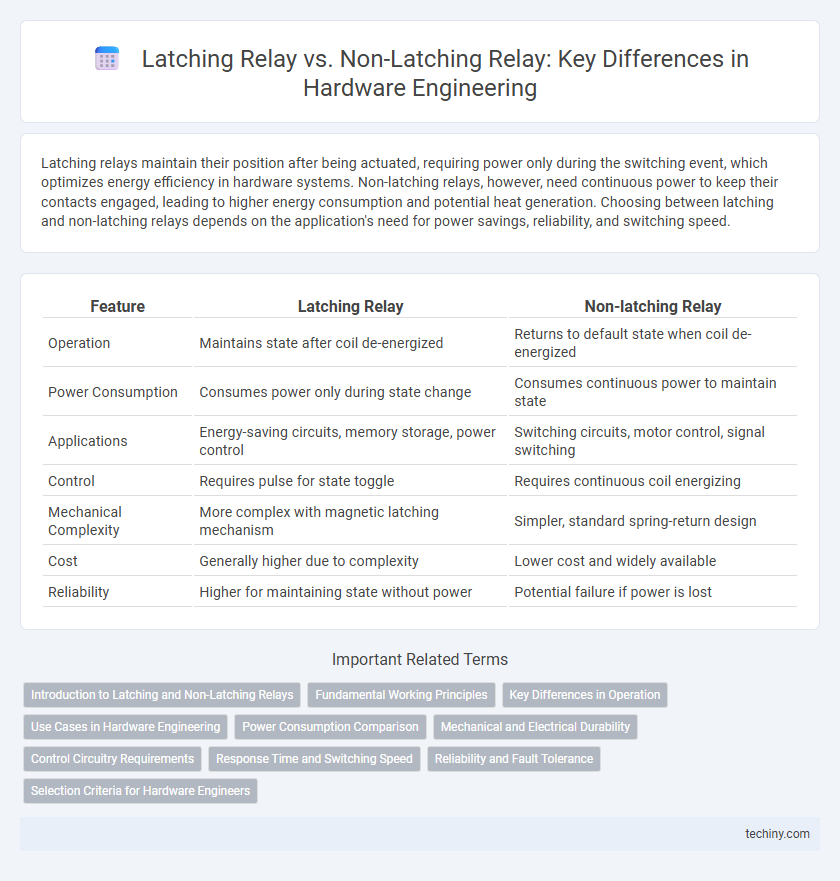Latching relays maintain their position after being actuated, requiring power only during the switching event, which optimizes energy efficiency in hardware systems. Non-latching relays, however, need continuous power to keep their contacts engaged, leading to higher energy consumption and potential heat generation. Choosing between latching and non-latching relays depends on the application's need for power savings, reliability, and switching speed.
Table of Comparison
| Feature | Latching Relay | Non-latching Relay |
|---|---|---|
| Operation | Maintains state after coil de-energized | Returns to default state when coil de-energized |
| Power Consumption | Consumes power only during state change | Consumes continuous power to maintain state |
| Applications | Energy-saving circuits, memory storage, power control | Switching circuits, motor control, signal switching |
| Control | Requires pulse for state toggle | Requires continuous coil energizing |
| Mechanical Complexity | More complex with magnetic latching mechanism | Simpler, standard spring-return design |
| Cost | Generally higher due to complexity | Lower cost and widely available |
| Reliability | Higher for maintaining state without power | Potential failure if power is lost |
Introduction to Latching and Non-Latching Relays
Latching relays maintain their contact position after the actuating current is removed, using a magnetic or mechanical latch mechanism, which makes them energy-efficient for applications requiring persistent states. Non-latching relays, also known as standard or monostable relays, return to their default position once the actuating current ceases, relying on a spring to reset the contacts. Understanding the operational differences between latching and non-latching relays is critical for hardware engineers when selecting components for memory retention, power consumption, and response time in electrical circuits.
Fundamental Working Principles
Latching relays maintain their state after the control power is removed by using a magnet or mechanical latch, enabling energy-efficient switching in hardware engineering. Non-latching relays require continuous coil energization to hold their position, relying on electromagnetic force to keep contacts closed. This fundamental difference influences power consumption, reliability, and applications in circuit design.
Key Differences in Operation
Latching relays maintain their contact position even after the control signal is removed, reducing power consumption in hardware systems, whereas non-latching relays require continuous current to hold the contact state. The operation of latching relays involves electromagnetic or permanent magnets to keep the relay in a latched position, enhancing efficiency in applications demanding sustained switching. Non-latching relays rely on coil energization for contact switching, making them suitable for rapid switching but less energy-efficient compared to latching types.
Use Cases in Hardware Engineering
Latching relays are ideal for power-sensitive hardware applications where maintaining state without continuous power is critical, such as in battery-operated devices or memory retention circuits. Non-latching relays are preferred in high-speed switching scenarios requiring frequent state changes, including motor control and automated test equipment. Choosing between the two depends on requirements for energy efficiency, switching speed, and state retention in hardware engineering designs.
Power Consumption Comparison
Latching relays consume power only during the switching action, maintaining their state without continuous power, making them highly energy-efficient for applications requiring infrequent switching. Non-latching relays require continuous power to maintain the coil's magnetic field and hold their position, resulting in higher overall power consumption. This distinction significantly impacts battery-powered and energy-sensitive hardware designs where minimizing power usage is critical.
Mechanical and Electrical Durability
Latching relays offer superior electrical durability by maintaining their state without continuous power, reducing coil stress and heat generation compared to non-latching relays that require constant current to hold the contact position. Mechanically, latching relays typically exhibit enhanced longevity due to less wear on coil components and reduced thermal cycling, prolonging operational life in demanding applications. In contrast, non-latching relays endure continuous energizing, accelerating mechanical fatigue and increasing the risk of contact degradation over time.
Control Circuitry Requirements
Latching relays require a more complex control circuitry as they need a pulse signal to toggle between states, which reduces power consumption by maintaining the state without continuous current. Non-latching relays demand continuous power to the coil to maintain the activated position, resulting in higher energy usage and increased thermal stress on the components. The choice between latching and non-latching relays significantly impacts the design and efficiency of control circuits in hardware engineering applications.
Response Time and Switching Speed
Latching relays offer significantly faster response times and reduced power consumption by maintaining their state without continuous coil activation, making them ideal for applications requiring swift and energy-efficient switching. Non-latching relays typically exhibit slower switching speeds due to the need for constant coil energization to maintain their position, which can increase response latency and energy usage. In hardware engineering contexts prioritizing rapid switching and minimal power draw, latching relays provide superior performance over non-latching alternatives.
Reliability and Fault Tolerance
Latching relays offer enhanced reliability and fault tolerance by maintaining their state without continuous power, reducing coil heating and energy consumption, crucial for long-term operation in hardware systems. Non-latching relays require constant power to hold their position, increasing failure risk due to coil overheating and wear over time. The inherent bistable design of latching relays improves system robustness in fault-prone environments, making them preferable for critical hardware engineering applications.
Selection Criteria for Hardware Engineers
Hardware engineers select latching relays over non-latching relays based on power efficiency and retention needs, as latching relays maintain their state without continuous power, reducing energy consumption in battery-powered applications. Non-latching relays are favored when fast switching and durability under frequent operation are required, given their simpler mechanism and quicker response time. Key criteria include hold torque, coil power requirements, switching speed, and application-specific reliability standards.
Latching Relay vs Non-latching Relay Infographic

 techiny.com
techiny.com